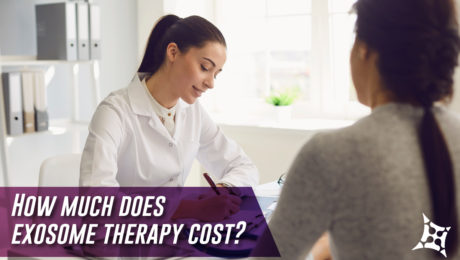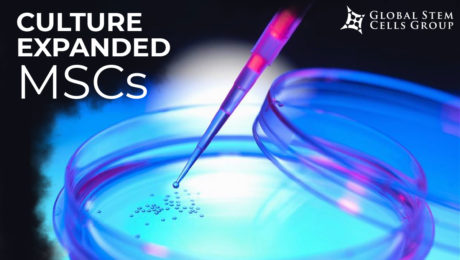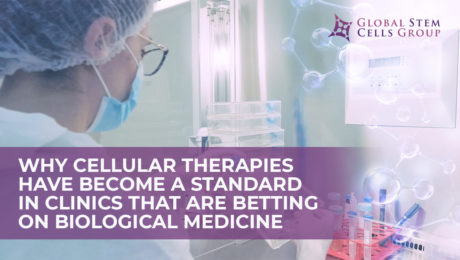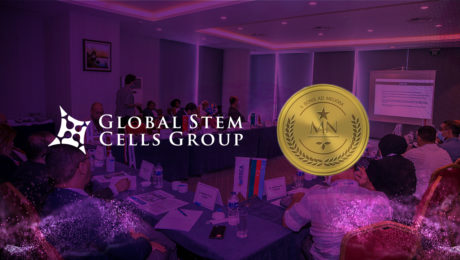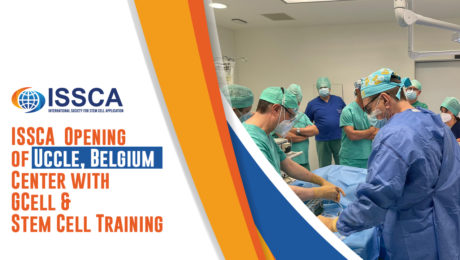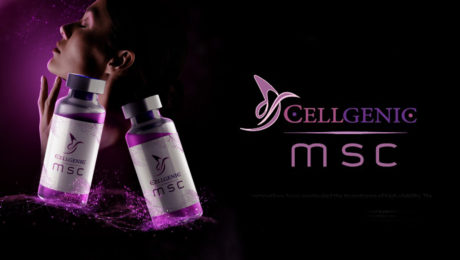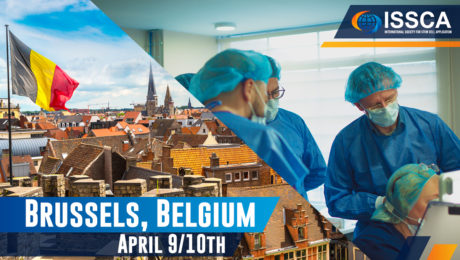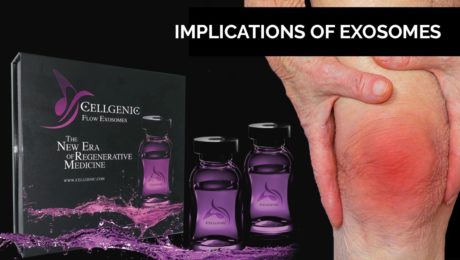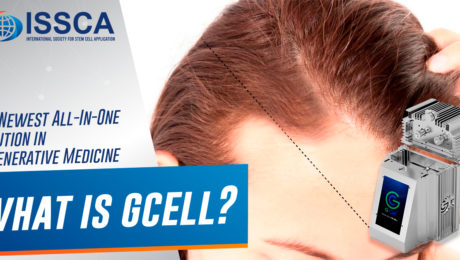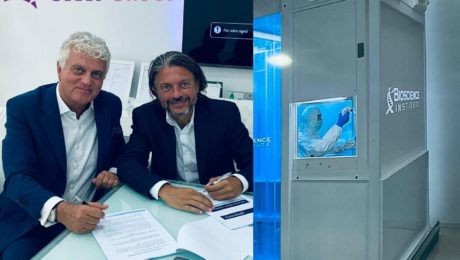How much does exosome therapy cost?
Exosome therapy is the new buzz in the regenerative medicine industry because of how it can repair and regenerate your cells and tissues.
Exosome therapy is safer compared to other cellular therapy because it’s a cell-free therapy with no risk of rejection.
Exosome therapy will be beneficial to you if you’re dealing with conditions such as sport injuries, tissue regeneration, hair loss, erectile dysfunction, chronic pain and so many other applications .
In this article, you’ll be learning the cost of exosome therapy and how you can benefit from exosome therapy.
How the cost of exosome therapy is determined
All cells produce exosomes, which are microvesicles that contain biochemical and genetic information.
Hence, the cost of an exosome product (used in exosome therapy) will depend on what type of cell line (raw tissue source) used to extract the exosomes.
The first factor to determine the cost of an exosome product depends on the quality of the tissue source.
The most commonly used tissue types are cord blood, amniotic fluid and mesenchymal cell cultures.
Exosomes derived from mesenchymal cell cultures are the most difficult to obtain but offer the greatest therapeutic potential.
How much does exosome therapy cost?
The average cost of exosome therapy is $4,900, but the price can be anything from $3,500 – $6,500.
It’s also important to note that the price depends on your specific needs and your treatment plan, as decided by the doctor.
The doctor will schedule a consultation with you to determine your personalized treatment plan.
The exosome therapy can either be given as an IV infusion or as localized injections, depending on the purpose of the therapy.
Exosomes are very useful to revitalize, rejuvenate, restore, and reduce inflammations in the body.
Here are some ways you can benefit from exosome therapy
Hair loss therapy: If you’re in the early stages of hair loss, with exosome therapy you can regenerate your hair whether you’re a man or woman. After exosome therapy, you’ll start seeing new hair growth in as little as two to three months with very significant results showing 6 months or 1 year later.
Chronic pain: In case you’re experiencing chronic pain due to degenerative conditions such as arthritis, exosomes can help to subdue the pain by regenerating the cells and helping the body work better.
Degenerative conditions: If you’re struggling with degenerative medical conditions such as osteoarthritis and musculoskeletal injuries, exosome therapy can help your body repair the damage done to your cells by these conditions, prevent them from getting better, and help you to feel better.
Skin therapy: exosome therapy can reduce inflammation in the skin by improving the strength and elasticity of the skin.
Anti-aging: if you would like to retain your youthful glow, exosome therapy can make you feel young again by rejuvenating your skin due to its ability to reverse the cells dying due to aging.
Where can you get exosome therapy?
Cellular hope institutes provide exosome therapy for patients looking for better outcomes for various conditions.
The exosomes used at Cellular Hope Institute are obtained from umbilical cord tissue that is discarded after a new birth , which means these Exosomes have not been exposed to any contaminating or toxic agent because our cells are as healthy as our body. This gives it a higher capacity to regenerate your cells and tissues.
- Published in Corporate News / Blog
Culture Expanded MSCs
Mesenchymal Stem Cells (MSCs) are the most commonly used cells in stem cell therapy and regenerative medicine, due to their high and multi-potency. Mesenchymal Stem Cells (MSCs) can be isolated from different tissues in the body.
In this article, you’ll be learning about culture-expanded MSCs, how MSCs can be expanded, The potency of MSCs and the type of cells they can differentiate into.
What are culture expanded Mesenchymal Stem cells?
Mesenchymal stem cells are high potent cells used for cellular therapy and isolated from different parts of the body. Mesenchymal stem cells can be used to improve the patient outcome in diseases and conditions such as autoimmune diseases, degenerative diseases, nerve damage, diabetes mellitus, bone problems etc.
For every patient, millions of mesenchymal stem cells are needed and the exact amount varies according to disease, route of administration, administration frequency, weight, and age of patient.
Mesenchymal stem cells are expanded in a culture media, on a large scale in order to obtain the required quantity of cells needed for cellular therapy.
Culture expanded MSCs: How does it work?
Expanding Mesenchymal stem cells in a media involves step by step process of isolation and expansion.
Mesenchymal Stem Cells Isolation
Mesenchymal stem cells can be isolated from different tissues in the human body such as adipose tissues, dental pulp, human bone marrow, umbilical cord tissue, umbilical cord blood, peripheral blood and synovium.
Mesenchymal stem cells are expanded in culture to increase their yield and amplify their desired functions and potency.
Although the population of Mesenchymal Stem Cells obtained will vary from donor to donor, here are some steps to follow:
· Acquire fresh tissue extracts in strictly aseptic conditions, to maintain purity.
· To remove any cell clusters, you have to filter the cell suspension with a 70-mm filter mesh
· Use a centrifuge to roll the cells for about 5 minutes at 500g
· Suspend the cells again the cells to measure the cell viability and yield using Trypan blue exclusion
· Use in T75 culture dishes to culture the cells in 10 mL of complete MSC medium at a density of 25 × 106 cells/mL. You can then go on to Incubate the plates at 37 °C with 5% CO2 in a humidified chamber without any interruption.
· When it’s past 3 h, remove the non-adherent cells that accumulate on the surface of the dish by changing the medium and replacing it with 10 mL fresh complete medium.
· After an additional 8 h of culture, add 10ml fresh complete medium as a replacement for the existing medium. You’ll have to repeat this step every 8 h for up to 72 h of initial culture.
· Cells can be frozen in MSC growth media plus 10% DMSO (D2650) at a density of 2X106 cells/vial.
Expansion of Mesenchymal Stem Cells in a culture media
Culture expanded mesenchymal cells undergo various stages from the preparation of the culture plate, thawing of Mesenchymal stem cells, and the actual expansion of Mesenchymal stem cells.
The reason behind the cultural expansion of Mesenchymal stem cells is to get them to differentiate into other cell types such as osteoblast, adipocyte, and mesenchymal stromal cells.
In preparation, to expand MSCs in a culture media, you need a culture ware. You can get one plastic or glassware plate and coat it with a sufficient amount of 0.1% gelatin. Don’t forget to aspirate the gelatin solution from the coated plate or flask before you use it.
The next step involves the thawing of the Mesenchymal stem cells, and here are a few steps for you to follow:
After the recommended culture medium and coated culture ware is ready and on standby, remove the vial of Mesenchymal Stem Cells from liquid nitrogen and incubate in a 37C water bath and pay close attention to it, until all the cells are completely thawed. The extent of completely thawed frozen cells and how fast, are what determines the cell viability.
Once the cells have thawed completely, take steps to avoid contamination by disinfecting the walls with 70% ethanol, before you proceed to the next step.
Place the cells in a hood, and carefully transfer the cells to a sterile tube with a pipette (1 or 2ml pipette), Do this in such a way to prevent bubbles.
Then, add drops of Mesenchymal Stem cell expansion medium that have been pre-warmed to 37C to the tube containing the Mesenchymal stem cells.
Be careful to take your time when adding the medium to avoid osmotic shock which could lead to decreased viability.
Proceed to mix the suspension slowly by pipetting up and down two times while avoiding any bubbles.
Place the tube in a centrifuge and centrifuge the tube at 300 x g for 2-3 minutes to roll the cells, and you should not vortex the cells.
After this, then decant as much of the supernatant as possible. These steps are necessary to remove residual cryopreservative (DMSO).
Suspend the cells in a total volume of 10 mL of Mesenchymal Stem Cell Expansion Medium again or any alternative of choice, pre-warmed to 37 °C, containing freshly added 8 ng/mL FGF-2 (F0291).
The next step involves placing the cell suspension onto a 10-cm tissue culture plate or a T75 tissue culture flask.
Maintain the cells in a humidified incubator at 37 °C with 5% CO2.
The next day, exchange the medium with fresh Mesenchymal Stem Cell Expansion Medium (pre-warmed to 37 °C) containing 8 ng/mL FGF-2*. Replace with fresh medium containing FGF-2 every two to three days thereafter.
Isolate the cells when they are approximately 80% confluent, using Trypsin-EDTA and passaged further or frozen for later use.
Expansion of Mesenchymal Stem Cells
Once the cells are actively proliferating and have reached a confluence of approximately 80% (before 100%), you should subculture the cells.
Then remove the medium from the 10-cm tissue culture plate containing the confluent layer of human mesenchymal stem cells, carefully and apply 3-5 mL of Trypsin-EDTA Solution, before proceeding to incubate in a 37 °C incubator for 3-5 minutes.
Crosscheck the culture to see if all the cells are completely detached. Then, add 5 mL Mesenchymal Stem Cell Expansion Medium to the plate.
Swirl the plate mildly to mix the cell suspension. Transfer the separated/isolated cells to a 15 mL conical tube.
Centrifuge the tube at 300 x g for 3-5 minutes to pellet the cells.
Throw the supernatant away and apply 2 mL Mesenchymal Stem Cell Expansion Medium (pre-warmed to 37 °C) containing 8 ng/mL FGF-2 to the conical tube and completely suspend the cells again. Remember not to vortex the cells.
Then, use a hemocytometer to count the number of cells.
Plate the cells at a density of 5,000-6,000 cells per cm2 into the appropriate flasks, plates, or wells in a Mesenchymal Stem Cell Expansion Medium containing 8 ng/mL FGF-2.
Cells can be frozen in MSC growth media plus 10% DMSO (D2650) at a density of 2X106 cells/vial.
Functions of Culture Expanded MSCs
Mesenchymal stem cells are required to be expanded in order for them to be used clinically for therapeutic purposes.
The culture expanded MSCs can be induced to differentiate into adipocytes, osteocytes, hepatocytes, chondrocytes, tenocytes and cardiomyocytes.
Because of its potential to differentiate into different kinds of cells in the body, it can be used to manage liver problems, heart problems, joint and bone problems etc.
Mesenchymal stem cells are also used in tissue regeneration and modulation of the immune system. They possess anti apoptotic, angiogenic, anti fibrotic, and anti-oxidative properties.
However, the quantity of MSCs isolated from body tissues is not enough for clinical and therapeutic applications.
This is why MSCs are expanded in culture to increase their yield for desired therapeutic effect.
- Published in Corporate News / Blog
Why cellular therapies have become a standard in clinics that are betting on biological medicine
Cellular therapy is fast becoming a standard therapy in many regenerative clinics today. Many doctors are no longer questioning the safety and effectiveness of stem cell therapy. This is because various stem cell studies are already describing the benefits of stem cells for patients who are living with chronic and autoimmune health conditions.
This article will be talking about why stem cell therapy have become a standard therapy in clinics, the paracrine effect of stem cells, and other reasons why doctors are adopting stem cells in their clinics.
Benefits of stem cell therapy
Stem cell therapy is an important innovation in medicine because of its regenerative power in the human body. Most disease states are characterized by damaged cells, tissues and organs, which is where stem cell therapy comes in. In stem cell therapy, stem cells are administered into the human body and it replaces the cells damaged by disease or health disorders.
Stem cell research has revealed two major ways of using stem cells to rebuild defective and damaged cells. One of these ways can be seen in procedures like bone marrow transplant, where stem cells are used to replace the damaged cells by engraving, and they then differentiate into the proper cell type. Another mechanism relies on the paracrine effect of stem cells. This procedure of stem cell therapy involves using stem cells isolated from a donor to stimulate the patient’s cells to repair damaged tissues.
Additionally, unlike traditional therapy, stem cells have a wide application. Stem cell therapy is used to manage various degenerative diseases, autoimmune disorders, birth defects, and the research is still ongoing for so many other health conditions where stem cells have shown potential.
Also, there is currently a high demand for aesthetic medicine. Stem cell therapy is a proven alternative to other forms of cosmetology such as plastic surgery. Hence, dermatologists are turning to stem cell therapy to administer anti-aging procedures, skin rejuvenation, hair therapy, micro-needling etc.
The Paracrine effect of stem cells
The paracrine effect of stem cells is one of the most outstanding effects of stem cells. It involves using donor cells to stimulate endogenous repair by harnessing the regenerative power of the human body. It is a mechanism of tissue regeneration that has created new possibilities for managing various conditions using stem cell therapy.
The cells that trigger a paracrine response are; mesenchymal cells, umbilical cord blood, umbilical cord tissue, adipose (fat) tissue and blood cells from a donor’s bone marrow.
The paracrine effect occurs when the donor’s cells send the damaged or defective cells signals to induce self regeneration and repair by secreting some factors and proteins. One of the mechanism by which this paracrine effect is initiated, involves the secretion of cytokines and regulatory proteins by the damaged patient’s cells, these cytokines and proteins act as mediators to stimulate an immune response that attracts the donor cells, this causes the donor cells to release proteins and factors that stimulate the patient’s cells to promote cell proliferation, increase vascularization and blood flow to the areas that needs to heal, while reducing inflammation.
Moreover, research has shown that the paracrine effect of stem cells prevents damaged and diseased cells from dying. They are also therapeutically useful in autoimmune diseases and preventing transplant rejection due to the immune suppression effect they have.
Is stem cell therapy effective?
Doctors are always looking for ways to provide the best possible treatment to their patients, and that is why many clinics are embracing stem cell therapy as a standard, due to its many advantages.
Stem cell therapy is one of the most effective and safest therapy patients can receive, when compared to other existing treatment options. Stem cell therapy is used in promoting patient outcomes in a lot of disease conditions that were previously poorly treated by other alternatives.
Again, as new potentials and ways of applying stem cells are being discovered, doctors are beginning to maximize these benefits in their clinics. Some conditions that are currently treated by stem cells include autoimmune conditions, immunotherapy Car-T cells, chronic obstructive pulmonary disease, neurodegenerative conditions, osteoarthritis, spinal cord injury, aesthetics/anti-aging, sports medicine, autism and multiple sclerosis.
Another reason clinics are adopting stem cell therapy as a standard therapy is because it is easy to administer. A lot of machines such as GCELL {Insert link} which makes the harvesting and processing of stem cells easy and fast, have made the procedures easily adaptable by doctors.
Furthermore, stem cell therapy reduces the treatment and recovery time associated with surgical procedures and other treatment options. This alone is a big factor in why stem cells are becoming a standard therapy in clinics.
Therapeutic uses of stem cells vs traditional medicine
Existing stem cell research has shown how the regenerative effect of stem cells is defining the future of medicine. The major advantage of stem cell therapy over conventional medication-based therapy is its safety. Stem cell therapy is aimed at treating the cause of the disease while traditional medicine targets the symptoms.
Another problem with traditional medical therapy is that it introduces another problem while trying to solve the existing one. As a doctor, you always run the risk of causing harm with each prescription because of various adverse effects that could lead to major organ damage of the kidney, liver etc. On the other hand, patients already know this and they are actively seeking better alternatives, this is why stem cell therapy is fast becoming a standard therapy in clinics.
Moreover, doctors will always be concerned about whether their patients are taking their medications or not. The burden of drug compliance and adherence associated with traditional medical therapy is not always easy to navigate. This is why effective treatment options like stem cell therapy have become a standard therapy in clinics. It only requires the patients having a procedure that repairs and restores damaged cells and tissues in the most natural way.
If you would like to become certified in regenerative medicine using stem cells and other cellular therapy, contact us.
- Published in Corporate News / Blog
Meso Numismatics Closes Global Stem Cell Group Acquisition
LAS VEGAS, NV, August 18, 2021 (GLOBE NEWSWIRE) — via NEWMEDIAWIRE — Meso Numismatics, Inc. (“Meso Numismatics” or the “Company”) (MSSV), a technology and numismatic company specializing in the Meso Region, including Central America and the Caribbean, MSSV is pleased to announce that it has closed its acquisition of Global Stem Cells Group. “We are pleased to have finally been able to close on this acquisition,” said David Christensen, President and CEO of MSSV,” We are now well positioned to enter into the growing global Regenerative Medicine industry.”
Global Stem Cells Group (Global) is a premier Regenerative Medicine company that specializes in cutting edge stem cell research, current clinical applications, and physician training. Global licenses its intellectual property and name to medical professionals around the world providing them with necessary equipment and cellular therapy products needed to perform safe and effective Regenerative medicine related treatments. Global has one of the larges physician membership networks in the world with 29 offices in more than 25 countries. The worldwide Regenerative Medicine industry is a multi billion-dollar industry projected to have double digit annual growth rates over the next decade. For more information on Global Stem Cells Group please follow the link www.stemcellsgroup.com
Please read this press release in conjunction with the 8K that was filed today on www.sec.gov.
MSSV has also renegotiated its June 22, 2021 $10.5M financing, of which $8.2M is earmarked for the Lans Holdings Escrow as per the 8k filed June 24th, 2021, as follows: the warrant maturity has been changed to 7 years instead of 3 years and the warrant shall be locked up for the first 2 years whereas during the lock up period the warrant will not be able to be exercised.
This press release should be read in conjunction with all other filings on www.sec.gov
For more information on Global Stem Cells Group please visit: www.stemcellsgroup.com
About Meso Numismatics: Meso Numismatics, Corp is an emerging numismatic and technology company specialized in the Meso Region, including Central America and the Caribbean. The Company has quickly become the central hub for rare, exquisite, and valuable inventory for not only the Meso region, but for exceptional items from around the world. With the Company’s breadth of business experience and technology team, the Company will continue to help companies grow. Meso has now added bio-technology to it’s portfolio and will continue to grow the company in this new direction.
This press release should be read in conjunction with all other filings on www.sec.gov
For more information on Global Stem Cells Group please visit: www.stemcellsgroup.com
About Meso Numismatics: Meso Numismatics, Corp is an emerging numismatic and technology company specialized in the Meso Region, including Central America and the Caribbean. The Company has quickly become the central hub for rare, exquisite, and valuable inventory for not only the Meso region, but for exceptional items from around the world. With the Company’s breadth of business experience and technology team, the Company will continue to help companies grow.
Forward Looking Statements
Some information in this document constitutes forward-looking statements or statements which may be deemed or construed to be forward-looking statements, such as the closing of the share exchange agreement. The words “plan”, “forecast”, “anticipates”, “estimate”, “project”, “intend”, “expect”, “should”, “believe”, and similar expressions are intended to identify forward-looking statements. These forward-looking statements involve, and are subject to known and unknown risks, uncertainties and other factors which could cause the Company’s actual results, performance (financial or operating) or achievements to differ from the future results, performance (financial or operating) or achievements expressed or implied by such forward-looking statements. The risks, uncertainties and other factors are more fully discussed in the Company’s filings with the U.S. Securities and Exchange Commission. All forward-looking statements attributable to Meso Numismatics, Inc., herein are expressly qualified in their entirety by the above-mentioned cautionary statement. Meso Numismatics, Inc. disclaims any obligation to update forward-looking statements contained in this estimate, except as may be required by law.
For further information, please contact:
Investor.relations@mssvinc.com
Telephone: (800) 956-3935
- Published in Press Releases
ISSCA Opening of Uccle, Belgium Center with GCell & Stem Cell Training
After several months of organizing and developing a location, the Global Stem Cells Group has finalized the construction of a laboratory and regenerative medicine research center in Uccle, Belgium.
This facility serves both as a regenerative medicine treatment and research center, but also as a plastic surgery clinic. In addition to this, one of the primary goals of the Center is to serve as a place for the fostering of knowledge and experience regarding the different products and equipment required for the application of cellular therapies. As part of the inaugural ceremony a group of physicians were trained in the setup and use of the various regenerative medicine protocols and application process of these cells into the patients.
This center is a push into Europe for the Global Stem Cells Group. As the science advances, newer and more advanced therapies and technologies are being developed and released into the market with each passing month.
With the European Union being one of the largest consumer markets in the world, the finalization of a brick-and-mortar location in Brussels, Belgium is one that will mean great things for the Global Stem Cells Group, and the presence and proliferation of regenerative medicine throughout Europe and the world.
“This was a wonderful opportunity that we could have. It goes to show that even during this pandemic, the medical community is one that is still going strong. We’re still rallying together to look for new breakthroughs, and come up with the most beneficial treatment options for patients,” Said Benito Novas, founder of the International Society for Stem Cell Applications, “In addition to this, it also provides an excellent platform for the distribution of regenerative medicine therapies and equipment, including the revolutionary new GCell Machine,”
Indeed, the inaugural training at the Stem Cell Center in Uccle, Belgium was one that covered both of the more traditional methods of stem cell isolation and application– adipose and bone-marrow derived autologous cells, but this training was also one of the first in which the company had the ability to demonstrate the novel GCell Machine. Using a precise system of blades and filters, it is able to process a stem cell sample from adipose tissue in less than half of the time that it would take a physician to do so through traditional means.
This allows the patient to be more comfortable throughout the shorter procedure, as less anesthesia is also required than when operating under traditional means. The GCell is a minimally invasive, portable machine that allows physicians to fully unlock the potential of regenerative medicine as a component in their practice. Using their global network of distributors and licensed vendors, Global Stem Cells Group is working fervently to ensure no interruption in the global availability of the most cutting-edge regenerative medicine products.
- Published in Press Releases
How Cellgenic MSCs Revolutionize Regenerative Medicine
Stem Cells are revolutionizing the field of regenerative medicine, due to their intelligence. Once administered into the patient, they are able to identify and target areas of disease and damage. Adimarket’s Mesenchymal Stem Cell Product excretes growth factors, cytokines, and proteins, which all play a key role in the regeneration of tissue. Their anti-inflammatory and immunomodulatory properties mean that it is difficult for them to be rejected by the body. Additionally, they increase blood flow to the vital organs which need it the most.
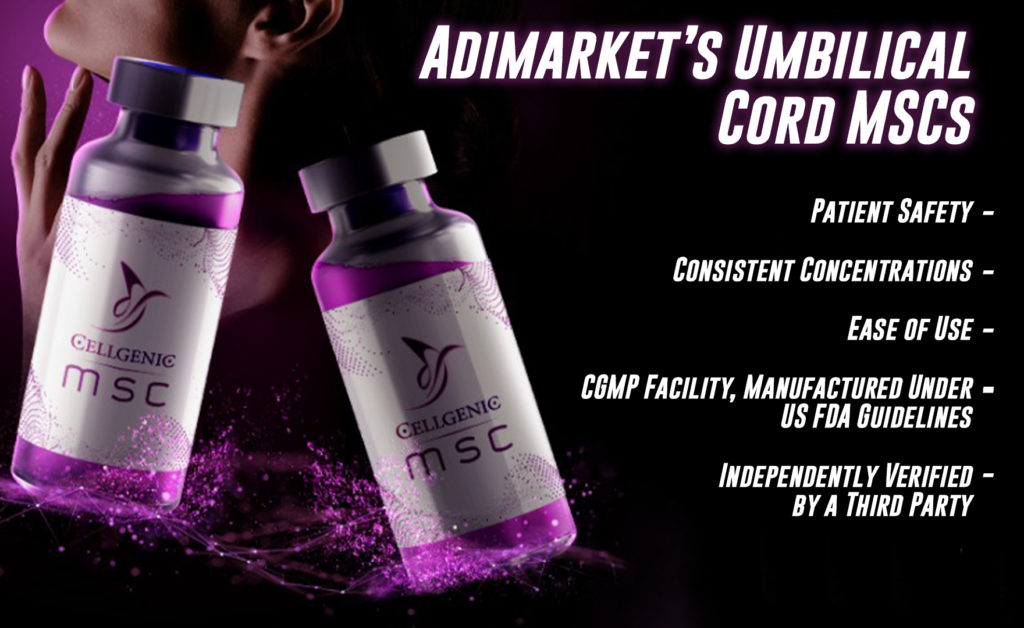
Many proprietors of MSC products will claim that it is not necessarily important to have a high ratio of viable cells. They claim that it does not matter how many cells are ‘not viable’, or dead, so long as there is a high enough number of viable cells– however, current research has shown that this is not the case. These dead cells are detectable by the immune system, and it is believed that they can create an inflammatory response within the body at the treatment area, which would lower the effectiveness of the regenerative medicine treatments.
This bending of the science is harmful to our industry, which is why knowledgeable purveyors put one thing above all else– consistency. Our cellular concentrations are the same throughout each batch, and we make sure that there is a high ratio of viable cells. All of our samples are independently verified by a third party laboratory, and have been selected for their phenotypic and genotypic profile, characterized for optimum growth and stability. When the proper care is taken, Mesenchymal Stem Cell products have been identified as having the highest output of growth factors and stem cell factors among the current standards of care– as well as properties of angiogenesis, immunomodulation, and the potential for endogenous repair.
Cellgenic has been working for over a decade, constantly reinventing itself and reinforcing the products that we offer with the latest advancements in the field of regenerative medicine. We take every painstaking measure possible to ensure that the cellular samples that our customers use to treat their patients are second to none– this includes the consistent concentrations of our sample, which are the same throughout ensuring that every patient gets the same treatment. We offer the product in 10 million or 30 million live total nucleated cells, where other fabricators would have the same number of total cells. We ensure that every single product that we send out has been tested for low amounts of annexin, which is a cellular protein which serves as a marker for cell death.
All our Mesenchymal Stem Cell products come in 1cc vials cryogenically preserved– they are shipped overnight within the United States, conveniently delivered to your door in the morning. For use, the product is passively thawed between the palms of your hands– and ready to use when your patients are. MSC 10 contains 10 million live cells and is recommended for a single joint, or a small area. However, the MSC pure pro has 30 million live cells,and can be used for larger applications, or for up to three joints in the same patient at the same time.
If you are interested in finding out more about Cellgenic MSCs, you can send an eMail to info@stemcellsgroup.com
- Published in Corporate News / Blog
Global Stem Cells Group Announces Training in Brussels, Belgium for April 9/10th
The Global Stem Cells Group, a multi-disciplinary community of scientists and physicians that are collaborating to treat diseases and lessen human suffering through the advancement of the field of regenerative medicine has announced plans for a training in Brussels, Belgium on April 9/10th. This course is a long-awaited return to the country of Belgium after months of inactivity in the region brought about by the COVID-19 pandemic. During this time, research proceeded, and shocking discoveries were made that further thrust regenerative medicine into the world’s stage, and as a result the curriculum has been reinforced with the latest in IV therapy and exosome protocols.
This training will be one of the first of 2021, reaffirming the Global Stem Cells Group’s presence in Europe as a key player in the field of regenerative medicine. Members from both Global Stem Cells Group & the International Society for Stem Cell Application’s Brussels Chapter will be there to assist in expanding research for and the practice of regenerative medicine across Europe.
“It’s good to know that the Global pandemic has not been able to stop the progress of business,” Says Benito Novas, founder and CEO of the Global Stem Cells Group, “With reopening happening slowly, but surely, we hope that more and more physicians and clinics will take up the benefits of regenerative medicine.As we continue to train patients with the GCell Machine, ”
This training is intended to teach physicians the value and process behind incorporating regenerative medicine into their own clinical practice. This includes a theoretical portion that goes over basic regenerative medicine biology and its application, but also includes a Hands-On portion in which doctors, in a controlled environment and guided by a team of medical professionals, will have the opportunity to see procedures be performed just a few feet away, and then get the opportunity to try it for themselves.
The Belgium Stem Cell Center is one that is outfitted with the latest technology in regenerative medicine processing, which ensures any students that pass through it receive an education in extraction, isolation, and application of Platelet-Rich Plasma, Adipose, and Bone Marrow-Derived Mesenchymal Stem Cells.
This training will also teach physicians how to utilize the GCell Machine to perform regenerative medicine therapies. GCell is a tissue homogenization device that is revolutionizing the future of regenerative medicine. It is an extremely compact, all-in-one unit that can homogenize and isolate the stem cells from an adipose sample. GCell’s process of homogenizing with a system of precise blades and filtering ensures that the sample can be processed within an hour, with little input from the physician when the machine begins to do its work.
Once the process is over, the end result is a final product that can be administered to patients within an hour after the initial tissue extraction. This is a far cry from the previous, muti-hour long treatments that physicians have grown accustomed to, and the shortened timespan and simplicity of the procedure is something that both doctors and their patients will greatly appreciate.
If you are interested in enrolling in this upcoming event, or to learn more about the different training opportunities available, you can visit us at our training website.
About Global Stem Cells Group
Global Stem Cells Group (GSCG) is a worldwide network that combines seven major medical corporations, each focused on furthering scientific and technological advancements to lead cutting-edge stem cell development, treatments, and training. The united efforts of GSCG’s affiliate companies provide medical practitioners with a one-stop
hub for stem cell solutions that adhere to the highest medical standards.
- Published in Press Releases
Implications of Exosomes
As the newest field to regenerative medicine, it’s often exosomes therapy the least understood by those doctors newer to the field. While still not in use by many doctors, this is simply because it is new to the field. This is because many scientists are practically rabid to harnessthe benefits of this new treatment and apply them to target many of the conditions that modern medicine has allowed to slip through the cracks.
Extracellular Vesicles and Exosomes
The discovery of extracellular vesicles (EV), small bubbles composed of protein freely among cells, has been considered one of the greatest advancements in the field of medicine. They are broadly defined as something that exists outside of the cells of the human body, and they can be quite unique. Among these are exosomes, which has shown almost miraculous promise in treating inflammation, immunomodulation, cell-cell communication, and much more. Although it is certainly not a cure-all, it has been found to be good at what it does, which is almost a little bit of everything.This includes the communication and rejuvenation of all cells in the body, despite not actually being one itself.
Exosomes are created by growing a healthy stem cell culture and disposing of the cells themselves– this leaves behind the exosomes, millions of them, that were created in the process. Due to their microscopic size, what is left behind must be ultra-centrifuged, as it is the only way to concentrate them enough to use them on a patient. Despite all of their abilities, the makeup of exosomes is really quite simple, amino acids and RNA– this means that, aside from bearing immunomodulatory properties, it can also be applied to a patient without causing an immune system reaction. This is a worry that modern physicians must constantly think about when implanting foreign objects into patients, that is one of the great benefits of the use of exosome therapy.
An Overview on Exosome Therapy
Generally defined, exosome therapy is the use of exosomes in a clinical setting, a new step forward that is being happily taken by physicians worldwide. Exosome Therapy has very rapidly become one of the most popular fields of regenerative medicine treatment around the world. Painstaking research has managed to highlight the practical uses of exosomes, and how they can be used to treat conditions including lyme disease, hair loss, and arthritis. This is because, while stem cells are largely responsible for the rejuvenation of older cells, they might not be able to supply the information required for healing to take place– and this is where exosomes come in.
Consider exosomes the traffic conductors of regenerative medicine. They stimulate attention to damaged areas and work to control inflammation. In fact, many talented researchers believe that, by supporting the function of exosomes in the body, a better outcome could be obtained in patients. These scientific breakthroughs have fundamentally changed the healing process as we know it.
Exosome therapy is minimally invasive, and most commonly used in patients that present with orthopedic injuries, but this is not it’s only use. It shows great applications for anti-aging medicine, and the treatment of inflammatory and degenerative diseases. Exosome treatments generally contain a combination of growth factors, messenger RNA, micro RNA, and cytokines. The resulting exosome treatment is used in conjunction with stem cell therapies to boost the healing process in patients. These exosome therapies can be administered directly into the affected area, but they can also be administered through IV drip for those that are looking to make use of the anti-aging properties of exosomes.
Exosome injections are administered like other cellular therapies– administered directly into the part of the body affected by disease. In each case, patient dosing varies on condition and treatment plan, which means that there is no exact treatment protocol for exosome therapy. However, this allows physicians to fully customize them to a patient’s needs.
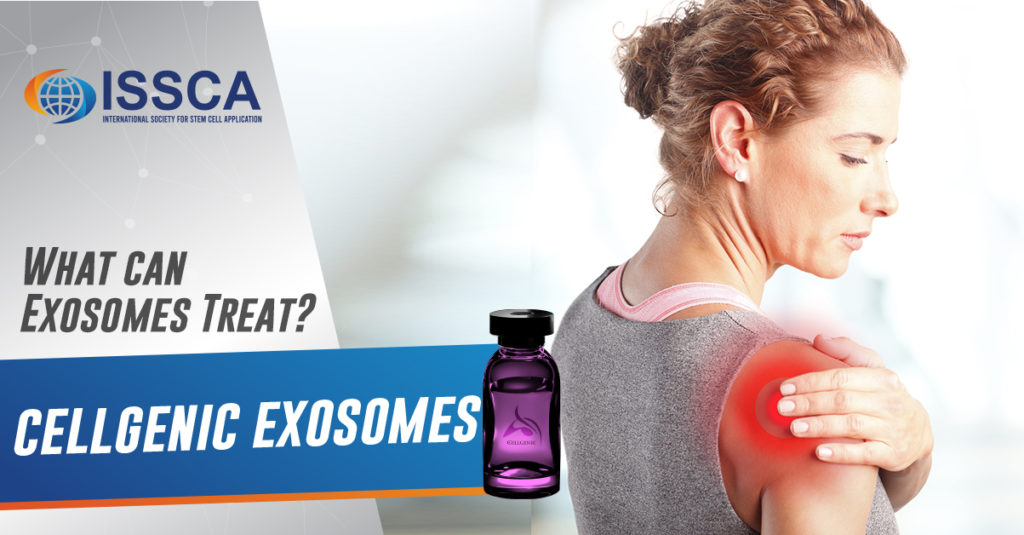
What can Exosomes Treat?
As the field of regenerative medicine constantly grows, more and more treatments are discovered every month! However, researchers have been able to offer exosomes as an exciting alternative for a wide variety of illnesses, including in arthritis therapy– it is believed to play a large role in bone and cartilage remodeling.Exosome therapy currently shows promise in treating the following conditions:
Hair Loss: Exosomes can be used to regrow hair due to their growth factor content. When injected exosomes trigger healing and the natural regeneration of hair follicles.
Lyme Disease: Exosomes may be beneficial to patients who suffer from Lyme disease, which is a very complex disease that compromises the immune system. Because it results in an increase in inflammatory responses, incorporating exosomes into one’s treatment plan could help break the cycle of inflammatory response.
Arthritis: Arthritis is known by many as the inflammation of the joints as a result of an autoimmune deficiency. Although various types of treatment are available to alleviate symptoms, nothing has been confirmed to reverse the disease’s progression.
Anti-Aging: Generally, aging can be thought of as a slow, steady inflammation of the body. Researchers have found a direct correlation between the number and types of exosomes within the body and the effects of aging, which means that exosome therapy could be used to reduce swelling in patients, and can be used to treat conditions such as crow’s feet, puffy eyes, and other markers of aging.
Pain Management: On a similar vein, many pain symptoms are also the result of inflammation– this is why certain over-the-counter medications allow for the treating of light pain. But for severe, chronic conditions that cannot be treated with over the counter options, exosome therapy could be the key to increasing their quality of life. By targeting the pained area at the source of inflammation, exosome therapy can increase quality of movement and reduce pain in certain orthopedic conditions including stress injuries.
As physicians around the world continue to study and apply exosomes, Global Stem Cells Group recognizes the fervent need to get these products into doctor’s hands. Our Cellgenic line has been in operation for years, helping physicians treat these conditions and more with exosome therapy.
- Published in Corporate News / Blog
GCell: The Newest All-In-One Solution in Regenerative Medicine
Are you a physician that is currently utilizing adipose tissue, but is growing tired of the time-consuming, arduous procedure? Are you having problems finding reagents that allow you to isolate stem cells? If so, GCell might be the solution for you.
What is GCell?
GCell is a revolutionary new machine that holds the potential to become the future of adipose stem cell processing. This is due to a variety of reasons, from the compactness of the unit, to its short processing time– it truly is a valuable implement in any regenerative medicine practitioner’s office. GCell employs a process of mechanical breakdown, which in addition to shortening the duration of the treatment, also serves to keep it within legal minimal-manipulation regulations.
How Does GCell Work?
Through a system of extremely small blades and filters, it is able to homogenize a sample of fat taken from anywhere in the body, making it into a slurry of growth factors, proteins, and the other components that make up the sample. The GCell then filters out the stromal vascular fraction cells, and uses a process called photoactivation to increase their vitality. Once the process is over, the end result is a final product that can be administered to patients within forty minutes from the sample’s harvesting. This is a far cry from the previous, muti-hour long treatments that physicians have grown accustomed to, and this shortened timespan is something that both doctors and their patients will greatly appreciate.
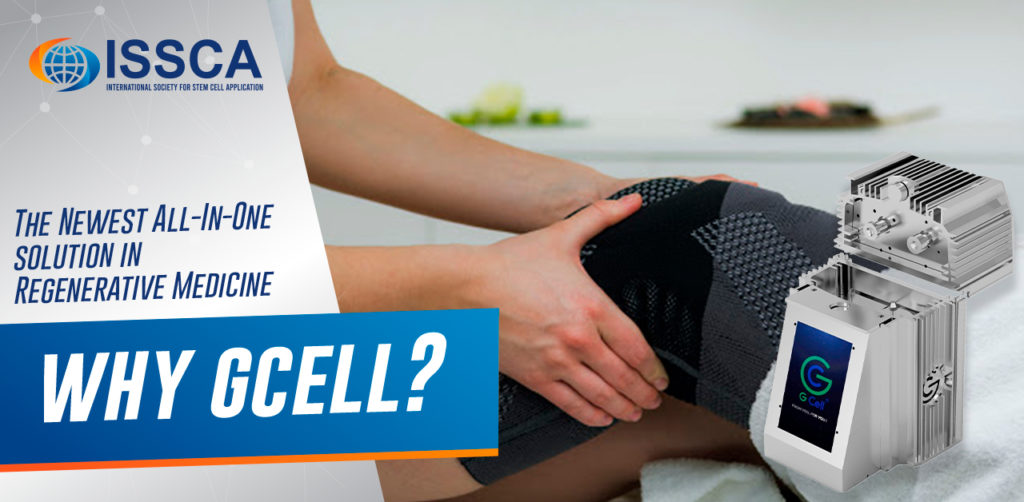
Why GCell?
Additionally, it is a single-session treatment. This means that patients that wish to receive a GCell treatment will only have to visit their clinic once, and will not have to undergo any followup treatments. This machine provides the convenience of its small size and lightweight build with the ability to accelerate the stem cell harvesting process– but that isn’t all. The GCell has been designed to be an entirely enclosed system– this is important, as it means that samples that are run through the GCell will remain in a sterile environment, which preserves the viability of samples and ensures positive outcomes for patients.
The GCell combines a grinder, a filter, and a photoactivation device, and is a turnkey solution that can take a physician from harvesting a fat sample to administering an injectable regenerative medicine therapy in less than an hour. GCell has been designed to be especially useful for clinics that are just beginning to implement regenerative medicine into their practice, but it’s all inclusive approach to stem cell isolation is what sets it a cut above the rest.
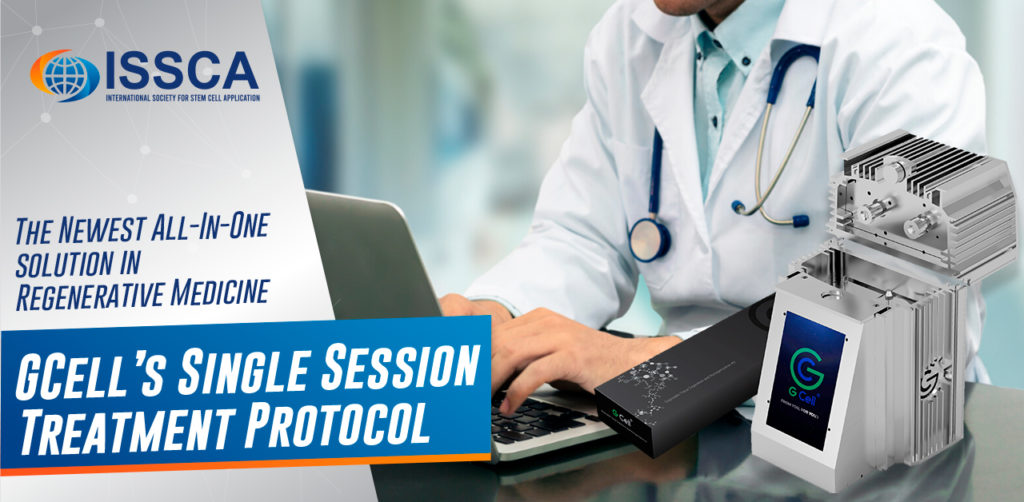
GCell’s Single Session Treatment Protocol
Unlike many other cellular therapies on the market, it is a single-session treatment, which means that there is no need for the patient to come back after his original treatment day has ended. This machine’s portability, small stature, and ability to accelerate the stem cell harvesting process makes it ideal for clinics that are just beginning to implement regenerative medicine into their practices, as it takes much of the rigor out of adipose-derived stem cell harvesting.
- Published in Corporate News / Blog
Global Stem Cells Group Announces Partnership with Bioscience Cell Factory
Just earlier this week, Global Stem Cells Group has signed a historic agreement with a company known as Bioscience Cell Factory– this Dubai-based healthcare company will allow GSCG to act as their representatives operating in both the Middle East and Latin America. Through the acquisition of proprietary branding rights Global Stem Cells Groups will become committed to promote the widespread use of cellular therapy treatments that utilize Mesenchymal Stem Cells (MSCs).
This partnership is groundbreaking in nature, and promises to lead to a wide proliferation of cellular therapies in both the Middle East and Latin America, two regions that are rapidly developing, with a constantly-advancing standard of medical care. Global Stem Cells Group will be clinically equipped with the highest standards and quality procedures as set forth by the Bioscience Cell Factory, resulting in nothing but the best treatment methods available for patients around the world.

“I’m extremely excited about this partnership,” Said Benito Novas, CEO of the Global Stem Cells Group, “Bioscience Cell Factory is one of the most professional and scientifically-focused teams that I’ve ever had the pleasure of working with– I am looking forward to the start of what will be an extremely beneficial professional relationship that will provide our global reach with the quality of Bioscience’s laboratory,”
Indeed, the two firms are also announcing plans to do research together into the nature of adult Mesenchymal Stem Cells, and the benefits that they hold for the medical field. Through the training of physicians and the handling of cell samples in their laboratory, there are high hopes for the advancement of the field of regenerative medicine research. As one of the representatives of the Bioscience Cell Factory abroad, Global Stem Cells Group will further its goal of being a global leader in the regenerative medicine field.
About Bioscience Cell Factory
Bioscience Clinic is a global healthcare company that is based in Dubai, committed to the running of a laboratory for the banking and use of all sorts of allogeneic and autologous cellular products. Through the proliferation of cellular therapies throughout the world, Bioscience Clinic hopes to advance treatment options for some debilitating diseases that current medical science has been largely unable to target the root causes of.
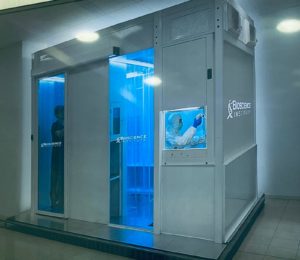
About Global Stem Cells Group
Global Stem Cells Group (GSCG) is a worldwide network that combines seven major medical corporations, each focused on furthering scientific and technological advancements to lead cutting-edge stem cell development, treatments, and training. The united efforts of GSCG’s affiliate companies provide medical practitioners with a one-stop hub for stem cell solutions that adhere to the highest medical standards.
- Published in Press Releases

